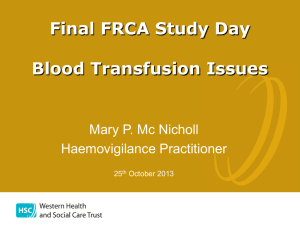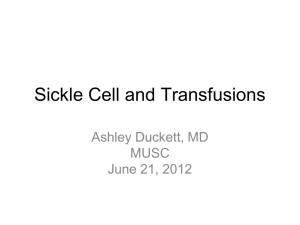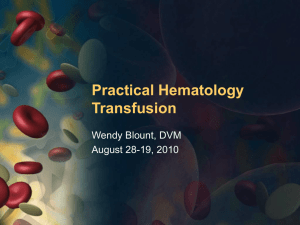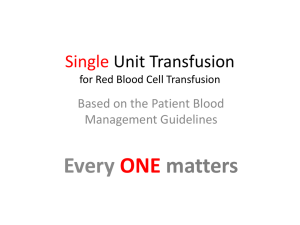AAA Blood and Bld Prods
advertisement
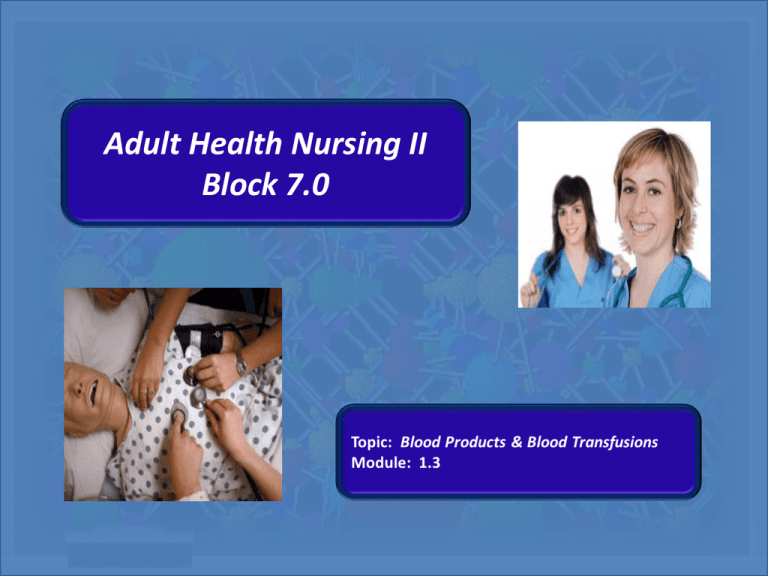
Adult Health Nursing II Block 7.0 Blood Products and Blood Transfusions Adult Health II Block 7.0 University of Southern Nevada Block 7.0 Module 1.3 Learning Outcomes • Discuss various blood components • Distinguish between various blood types • Compare and contrast indications for various types of blood transfusions • Describe nursing responsibilities prior, during, and post blood transfusion • Prioritize plan of care for clients experiencing transfusion reactions and complications Block 7.0 Module 1.3 Blood Components • Packed Red Cells- Anemia, Hg <6-10g/dl • Platelets- Thrombocytopenia, Plt count < 80,000 • Fresh Frozen Plasma- Deficiency in coagulation factors, PT or PTT 1.5 times normal • Cryoprecipitate- Sepsis, neutropenic infection not responding to antibiotic therapy, clotting problems, usually given IV push over a few minutes • Albumin- Replace for low albumin • Whole Blood-Traumatic injuries, extensive burns, dehydration, shock Block 7.0 Module 1.3 Albumin • • • • • • • Expands circulating volume Used to Treat: Hypovolemia Burns Adult Respiratory Distress Severe Nephrosis Cirrhosis Block 7.0 Module 1.3 Albumin and Nursing Considerations • • • • • Monitor Vital Signs Monitor Central Venous Pressure Assess Respiratory Status for Overload Must be given IV Assess Lab Values- Look for an increase in the albumin level after transfusion • Assess edema Block 7.0 Module 1.3 Blood Types-ABO System • Blood Type is based on the presence of antigens • Must check for compatibility to prevent any reaction • A antigen= Type A blood type • B antigen=Type B blood type • Both A and B antigens=Type AB blood type • Neither A nor B antigen = Type O blood type Block 7.0 Module 1.3 Blood Types • Within the first few years of life circulating antibodies develop against the blood type antigens that person did not inherit • EX: A person born with/inherited Type A blood forms antibodies against Type B blood, a person born with/inherited • Type O blood has not ‘inherited’ either A or B antigens and will form antibodies against RBCs with either A or B antigens. • If RBCs that have an antigen are infused in a person who does not share that antigen a reaction can occur. Block 7.0 Module 1.3 Blood Types and Compatibility Blood Type Antigen Antibody Compatible With: A A B A,O B B A B,O AB AB O A, B, AB, O O O A,B O Block 7.0 Module 1.3 Rh Factor • Rh system is different than ABO system • An Rh negative person is born without the Rh antigen, and does not form antibodies unless exposed to the antigen • Exposure can occur if the person receives Rh positive blood or exposure during pregnancy/birth • Once an Rh negative person is exposed, any contact with Rh positive blood will trigger a reaction • NOTE: An Rh+ person can receive blood from a Rh negative donor, but Rh negative people should not receive Rh+ blood • Therefore: O- is the universal donor and AB+ is the universal recipient Block 7.0 Module 1.3 Blood Transfusions • Types: • Transfusions from blood donors • Autologous- Client’s own blood is collected and used for an elective surgery. Only can be used by the client. • Intra-operative- Blood loss during surgery is collected through a “cell saver” machine and re-transfused to client during procedure or for a set # of hours after a procedure. Block 7.0 Module 1.3 Indications for Transfusions • • • • • Excessive blood loss- Trauma, Surgeries Anemia Chronic Renal Failure Coagulation Deficiencies Thrombocytopenia Block 7.0 Module 1.3 Transfusion Procedure • Nursing Considerations and Actions for transfusions are pre-transfusion, during the transfusion, and post-transfusion • I would know this if I were you Block 7.0 Module 1.3 Pre –Transfusion (Prior) • • • • • • • • Assess lab values- Hg, Hct, Albumin, PT, PTT Verify order for blood transfusion Obtain Type and Crossmatch (ABO/Rh) Obtain patient consent Initiate IV (large bore usually #20 minimum or larger) Always use Y-connector tubing (comes with a filter) Always use Normal Saline (.9NS) for transfusion Always use a pump for controlled infusion time Block 7.0 Module 1.3 Pre-Transfusion (Prior) • Obtain baseline vital signs- Especially temp. • Assess patient history to see if patient has ever had a reaction to blood • Obtain blood from blood bank- Check bag • 2 nurse verification- Match patient ID band to blood bag and slip for name, record number, blood type, blood unit number, expiration date and DOCUMENT on the blood slip Block 7.0 Module 1.3 During the Transfusion • Remain with patient during the first 15-30 minutes of the transfusion- Hemolysis • Infuse at prescribed rate- Assess for overload • Monitor vital signs (per agency policy) • Notify primary care provider immediately for any signs of reaction Block 7.0 Module 1.3 Post Transfusion • Obtain vital signs and chart them on the blood slip • Dispose of the blood administration bag and tubing per agency protocol…usually in biohazard waste. • Reassess lab values- Hg should rise 1gm/dl with every unit transfused. Block 7.0 Module 1.3 Blood Transfusion Absolutes!!! • Must ALWAYS be administered with Normal Saline (NS) • NEVER mix blood with any medications or administer medications through blood line • As a nursing student you may NOT be a cosigner for blood transfusion administration • Infusion time (1 unit) should not exceed 4 hours Block 7.0 Module 1.3 Client Education • • • • • • Explain procedure and process Explain indication for transfusion Explain complications Allow client time to ask questions Assess understanding Obtain consent Block 7.0 Module 1.3 Cultural Considerations • Some clients of certain faiths or cultures will not accept blood transfusions. • Autologous transfusions may be an alternative • Must respect and accept these clients’ wishes Block 7.0 Module 1.3 Older Populations • • • • Assess circulatory, renal, fluid status Higher risk for circulatory overload and CHF Use no larger than a 19 gauge needle Monitor vital signs paying particular attention to heart rate, BP, and respirations • Lower rates of transfusion- Normal transfusion time is 2 hours but may need to transfuse over 4 hours Block 7.0 Module 1.3 Transfusion Reactions • • • • • Acute Hemolytic Febrile Mild Allergic Anaphylactic Circulatory Overload Block 7.0 Module 1.3 Acute Hemolytic • Onset IMMEDIATE!! • Etiology Blood Type or Rh incompatibility • • • • • • • • • • Signs and Symptoms: Chills, Fever, Low Back Pain Tachycardia, Tachypnea Chest Tightening or Pain Anxiety, “Impending Doom” Complications: Cardiovascular Collapse Renal Failure DIC, Shock, and Death Block 7.0 Module 1.3 Febrile • Onset: • 30 minutes- 6 hours after transfusion • Etiology: Most often in clients with anti-WBC antibodies usually developed after multiple transfusions • • • • Signs and Symptoms: Chills, Fever, Flushing Headache Anxiety Block 7.0 Module 1.3 Mild Allergic • Onset: • During or up to 24 hours after transfusion • • • • Signs and Symptoms: Itching Urticaria Flushing Block 7.0 Module 1.3 Anaphylactic • Onset: IMMEDIATE!!!! • • • • • • • Signs and Symptoms: Wheezing Dyspnea Chest Tightness Cyanosis Hypotension Feeling of Throat Closing Block 7.0 Module 1.3 Nursing Care of Transfusion Reactions nurse • STOP TRANSFUSION IMMEDIATELY • Start a saline infusion using a separate IV line nurse • Save the blood bag with the remaining blood and IV tubing • Notify primary care provider • Acute Hemolyic nurse • Monitor Vital Signs, I & O • Oxygen PRN Block 7.0 Module 1.3 Nursing Care of Transfusion Reactions • Febrile Nurse Nurse Nurse • STOP TRANSFUSION • Administer antipyretics • Use white blood cell filters • Notify primary care provider • Complete transfusion reaction form per policy • May resume transfusion if symptoms resolve Block 7.0 Module 1.3 Nursing Care of Transfusion Reactions • Mild Allergic nurse • Administer Antihistamines • Administer leukocyte reduced or “washed” RBCs nurse • Symptomatic- Stop transfusion • Asymptomatic- may slow down and continue transfusion nurse Block 7.0 Module 1.3 Nursing Care of Transfusion Reactions Anaphylactic STOP TRANSFUSION IMMEDIATELY!!! AND CALL PCP MAINTAIN AIRWAY ADMINISTER O2 IV FLUIDS Block 7.0 Module 1.3 ANTIHISTAMINES CORTICOSTEROIDS VASOPRESSORS Circulatory Overload • • • • • • • • • Signs and Symptoms Dyspnea Chest Tightness Tachycardia Tachypnea JVD Peripheral Edema Sudden Anxiety Crackles at lung bases • • • • • Nursing Care SLOW THE RATE Administer O2 Monitor Vital Signs Notify PCP Block 7.0 Module 1.3



